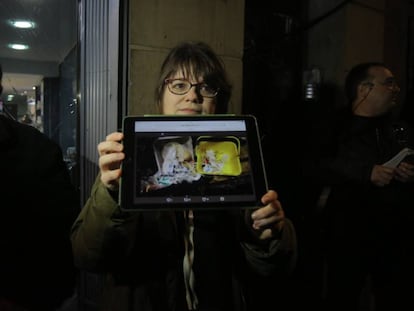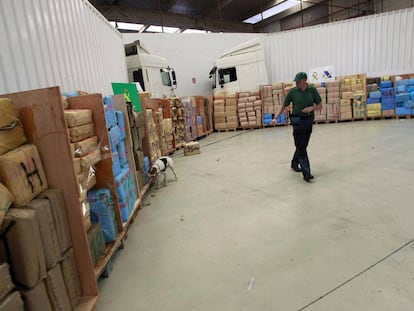How the drug gangs in Spain’s La Línea are providing work for 3,000 people
Increasingly violent traffickers are taking control of the city’s neighborhoods and ruling with impunity, to the rising concern of locals and authorities alike


Pepe takes a long drag on his cigarette, made up of a cocktail of tobacco and hashish. “Today half of all of this would have been mine but I gave it up. Business has changed a lot, now they are not just narcos, they are killers,” says Pepe, which isn’t his real name, as he exhales the narcotic cloud on a sunny morning at the El Tonelero beach in La Línea de la Concepción.
They have thrown out whatever shame they had. These are mafias that don’t care about killing or being killed
Retired trafficker Pepe
The 62-year-old has dark skin and a face marked with wrinkles. His care with money and sincerity are highly valued in La Atunara neighborhood, the drug epicenter of southern Spain. In the middle of the day, police and civil guards armed to the teeth have descended on the suburb. A group of drug traffickers has been caught and 13 people detained. Neighbors gather to see the commotion. Some are quiet. Others yell “Snitches!” at the police and journalists.
“You have chosen a bad day. You should be careful,” says Pepe, who worked in the 1980s shipping hashish but is now retired. There is nothing casual about the police operation. After 20 hooded men raided a local hospital to rescue one of their number, police have launched preemptive missions against the aggressive and treacherous drug gangs that have taken over Campo de Gibraltar. Just in La Línea, a city with only 63,279 people, police officials estimate that there are 30 gangs with more than 3,000 direct collaborators. “They have thrown out whatever shame they had. These are mafias that don’t care about killing or being killed,” says Pepe.
“The child has grown up. He began with monkey business and moved on to contraband tobacco and then hashish,” says Juan Franco, the major of La Línea, speaking about crime in the town. The city that borders both the British offshore territory of Gibraltar and Morocco is the gateway for drugs to arrive in Europe. In 2017, 145,372 kilos of hashish were apprehended compared to 100,423 kilos in 2016 – an increase close to 45% with 755 people arrested, Interior Minister Juan Ignacio Zoido said on Monday on a visit to the city. While the minister stresses the area “is not going to be controlled by drug traffickers,” those responsible for policing the region think differently. “There is an evident spike in aggression. They use force, weapons and have no mercy,” says Macarena Arroya, Campo de Gibraltar’s anti-drugs prosecutor.
“Certain ethics”
Brought up in families of local drug traffickers, today’s narco has learned the job from his elder relatives and taken it to another level. “It’s not that I want to romanticize them but the earlier generation had certain ethics,” says Franco.
Pepe would travel 14 kilometers in a small boat to pick up two or three bundles of hashish. He worked with bosses who preferred to keep a low profile and, although he was never arrested, he knew how to treat the police. “If a guard picked you up, you gave in because they had caught you.” But those days are long gone. Today, inflatable boats transport two to three tons and the new generation do everything to resist arrest. It hasn’t helped that this developed in the middle of the crisis with unemployment rates in La Línea around 42% (today they are 33%) and a serious shortage of police officers. The police union SUP estimates that the city is short 100 police officers while the Civil Guard Association (AUGC) believes that 300 civil guards are needed in Algeciras.
With police forces stretched and hashish valued at €1,640 a kilo, the drug business has invested in ways to become more sophisticated. “They are light years ahead. Their infrastructure is much better than ours,” says Arroyo. As well as radars, the gangs typically use encrypted telephones, drug boats with at least three outboard engines and a wide network of informants. “If you get in a car in one of their areas, any of the people who are surveilling you will send your license plate number to a group that they have to see if they have you registered. They even use cameras to control the city,” said a police officer who preferred to use the fake name Eduardo. A walk through the La Atunara neighborhood comes with hostile looks from young people, between 20 and 30, with unfriendly faces. For outsiders or police officers, strolling too far, asking too many questions or taking out a camera could lead to threats and stone throwing.
It’s not that I want to romanticize them but the earlier generation had certain ethics
Mayor Juan Franco
Eduardo is not even surprised about what happened recently at the hospital. Last year, during an arrest at a beach, he saw how groups of locals surrounded six officers and tried to pull out the detainee from the police vehicle. In April 2017, around 100 people threw stones at officers who were trying to intercept a drug exchange in El Tonelero. In the early hours of last Monday, three hooded men entered a judicial deposit in Conil de la Frontera with guns to steal drug money. Jeep attacks against police cars and the use of weapons (five Kalashnikov rifles were recorded in one record) are now common. “Impunity is absolute,” says Juan, a civil guard from La Línea. Juan estimates that “up to 10 boats loaded with hashish arrive every day” to the city’s coast. He says as many as 30 gangs are working in the area and “each one gives direct employment to around 100 people.” They are a minority but “they have spread their tentacles to such a point that they reach all parts of society,” says Franco.
In neighborhoods controlled by drug gangs, the narco applies their own law based on generosity, living peacefully and in silence. “It is not solidarity. If they give something, they will charge for it,” insists Juan. They don’t just buy their neighbor’s complicity. Police agents and civil guards have arrested many of their colleagues for accepting bribes from drug traffickers, says José Encinas from AUGC.
The traffickers have introduced their narco-culture wearing tracksuits and driving luxury cars. The mayor explains: “They think they’re a kind of nobility, and organize weddings of convenience. That’s how they create links between the gangs and guarantee silence between families.” Their ostentatious habits have even arrived in the stores in the center of twon. In one – which is under suspicion, given that it belongs to the wife of a drug boss – the store windows are a shine to sports clothing and the brands beloved of the gangs. “They like to be showy,” Juan admits, always keeping a close eye on his surroundings. “When you see one of them with a black tracksuit, a flashy watch, and perfectly groomed hair and beard... you know,” he says with a half-smile.
With police forces stretched and hashish valued at €1,640 a kilo, the drug business has invested in ways to become more sophisticated
And they have an example to follow: Los Castañas clan, led by brothers Antonio and Francisco Tejón, the lords of the city’s drug-trafficking racket. They control 60% of the hashish trade and “are heroes in their world,” says José Encina from AUGC. In La Línea, many are talking about drug crime in the city. “We are alarmed, disgusted, we feel hopeless and abandoned,” says Franco. On February 27, there will be a protest in the afternoon to say “enough” of the drug violence. They want La Línea to be declared an exception zone and are asking for police numbers to be reinforced, specialized courts and economic and social measures to help the region.
In the meantime, the wheel keeps on spinning. The gang dismantled last Thursday faced trial the next day. In court, family and friends of the 13 people detained wait for a verdict. Inside, Arroyo is at the point of asking for pre-trial detention without bail for 10 of the detainees. After more than a year of investigation, 30 raids and four tons of seized hashish, the case is finally going before a judge. The defense lawyers try to delay the process or dispute a piece of evidence, especially the tapped telephone calls. Nobody dares to predict what is going to become of La Línea. “Given no one takes action, the future looks very dark,” concludes Encinas.
English version by Melissa Kitson.
Tu suscripción se está usando en otro dispositivo
¿Quieres añadir otro usuario a tu suscripción?
Si continúas leyendo en este dispositivo, no se podrá leer en el otro.
FlechaTu suscripción se está usando en otro dispositivo y solo puedes acceder a EL PAÍS desde un dispositivo a la vez.
Si quieres compartir tu cuenta, cambia tu suscripción a la modalidad Premium, así podrás añadir otro usuario. Cada uno accederá con su propia cuenta de email, lo que os permitirá personalizar vuestra experiencia en EL PAÍS.
¿Tienes una suscripción de empresa? Accede aquí para contratar más cuentas.
En el caso de no saber quién está usando tu cuenta, te recomendamos cambiar tu contraseña aquí.
Si decides continuar compartiendo tu cuenta, este mensaje se mostrará en tu dispositivo y en el de la otra persona que está usando tu cuenta de forma indefinida, afectando a tu experiencia de lectura. Puedes consultar aquí los términos y condiciones de la suscripción digital.
More information
Archived In
Últimas noticias
The complicated life of Francesca Albanese: A rising figure in Italy but barred from every bank by Trump’s sanctions
Half of Scotland is in the hands of 420 property owners
Reinhard Genzel, Nobel laureate in physics: ‘One-minute videos will never give you the truth’
Pinochet’s victims grapple with José Antonio Kast’s rise in Chile
Most viewed
- Pablo Escobar’s hippos: A serious environmental problem, 40 years on
- Why we lost the habit of sleeping in two segments and how that changed our sense of time
- Charles Dubouloz, mountaineering star, retires at 36 with a farewell tour inspired by Walter Bonatti
- Trump’s obsession with putting his name on everything is unprecedented in the United States
- The Florida Keys tourist paradise is besieged by immigration agents: ‘We’ve never seen anything like this’










































